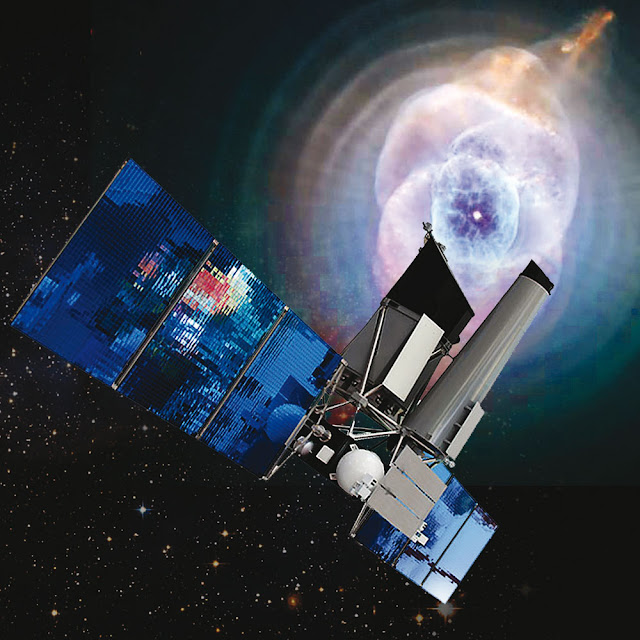ROSCOSMOS / DLR - Spektr-RG (Spectrum-RG) patch.
Jan 21, 2022
AT2020mrf could have remained one of many hundreds of ordinary optical transients that are regularly detected by the ATLAS meteor warning system. However, at the same place and at about the same time, the eROSITA telescope of the Russian orbital observatory Spektr-RG discovered an unusual new X-ray source SRGe J154754.2+443907. After that, it became clear that scientists had discovered a unique space object.
We probably witnessed the birth of a new magnetar - a neutron star with a superstrong magnetic field (~1014 Gauss) or a black hole in a distant galaxy. What does "cow" mean here?
Image above: Artistic illustration of the two most likely models of a compact object in cow-type supernovae: a black hole accreting matter in a supercritical regime to form relativistic jets (left) and a rapidly rotating neutron star with a superstrong magnetic field (right).
During the second all-sky survey in July 2020, the eROSITA telescope discovered a new source in a place where X-rays have not yet been detected. An analysis of databases of optical transients (transients are objects that suddenly appear in the sky in an “empty” place) showed that about 40 days earlier, in the same place, the American ground installations ZTF (Zwicky Transient Facility) and ATLAS (Asteroid Terrestrial-impact Last Alert System) registered at first glance the most ordinary optical transient, which was called AT2020mrf. Initially, AT2020mrf was classified as an ordinary collapsar supernova - the so-called type II supernova, formed when a massive star collapses at the end of its life. The discovery of X-rays and the shape of the source's optical light curve fundamentally changed this idea. It became clear that astrophysicists encountered an interesting object.
There is a class of optical transients associated with supernova explosions, which are characterized by "fast" light curves and a blue excess in the continuum - the so-called FBOT (Fast Optical Blue Transient). It is difficult to study them because their brilliance falls off quickly. However, among them there is the most mysterious and extremely rare subclass, the so-called objects of the AT2018cow type. The names of optical transients detected by the ATLAS facility (hence the letters "AT" in the name) are given according to the year of detection (in this case 2018), followed by a random combination of several letters generated by a computer. In the case of the AT2018cow event, these letters formed the English word cow ("cow"), which gave such an unusual name to this class - objects of the "cow" type.
Image above: X-ray images of a section of the sky measuring 3x3 arcmin. around the position of AT2020mrf /SRGe J154754.2+443907 obtained by the SRG/eROSITA telescope during four successive sky surveys in 2020-2021. (Click on the image for enlarge).
Flashes of "cows" are characterized by a record luminosity, which at the peak can reach 1043 erg / s, which is about 1000 times brighter than ordinary supernovae-collapsars. Such luminosity cannot be explained by the decay of radioactive nickel-56 and requires alternative energy sources. Prior to the discovery of SRGe J154754.2+443907, only four such objects were known; the eROSITA source became the fifth.
“SRGe J154754.2+443907 was discovered by the team of the eROSITA telescope at IKI RAS during the search for tidal destruction of stars by supermassive black holes, it soon became clear that we were not dealing with a tidal destruction event,” says one of the participants in this study, Head of the Laboratory of Experimental Astrophysics of the IKI RAS, Professor of the Russian Academy of Sciences Sergey Sazonov.
“A wide international campaign to study a new source at many wavelengths: from radio to X-ray, in which astrophysicists from the IKI RAS took an active part, confirmed that SRGe J154754.2+443907 is the fifth cow-type object. The multiwavelength observations of SRGe J154754.2+443907 involved the 10-meter Keck optical telescope in Hawaii, the largest VLA and GMRT radio telescopes, the Chandra and Swift and XMM-Newton space X-ray observatories. The program was coordinated by a PhD student from the California Institute of Technology, Yuhan Yao,” says Rashid Sunyaev, scientific director of the Russian Spektr-RG observatory.
“The eROSITA telescope observed this object shortly after the peak of the light curve. These observations showed that AT2020mrf /SRGe J154754.2+443907 is the brightest known core, with a luminosity of over ~2×1043 erg/s. Such a luminosity could be explained by a young rapidly rotating (with a period of the order of 10 milliseconds) neutron star with a superstrong magnetic field (of the order of 1014 Gauss) - the so-called magnetar, or a newly born black hole accreting the matter of the exploded progenitor star in the supercritical regime. In any case, there is no doubt that we have witnessed the birth of a relativistic compact object as a result of the explosion of a massive star,” says Marat Gilfanov, Chief Researcher at IKI RAS, RAS Corresponding Member.
Spektr-RG (Spectrum-RG)
An article about this discovery was sent to the international astrophysical journal The Astrophysical Journal and posted on the preprint site arXiv.org:
https://arxiv.org/abs/2112.00751
AT2020mrf /SRGe J154754.2+443907 has already died out, and many questions remain unanswered. To clarify the nature of such sources and understand the physical mechanisms that determine their behavior, it is necessary to find and study in detail new objects of this class in a timely manner. An important role in this work is played by the ongoing survey of the entire sky by the eROSITA telescope. The group for the study of extragalactic transients according to the data of the eROSITA telescope at the IKI RAS, which includes RAS Corresponding Member Marat Gilfanov, RAS Professor Sergei Sazonov, Academician Rashid Sunyaev, young Ph.D. x-ray sky.
Source: IKI RAS.
Related links:
ROSCOSMOS Press Release: https://www.roscosmos.ru/33877/
IKI RAS: https://www.roscosmos.ru/tag/iki-ran/
Spektr-RG: https://www.roscosmos.ru/tag/spektr-rg/
Images, Text, Credits: ROSCOSMOS/IKI RAS/Orbiter.ch Aerospace/Roland Berga.
Best regards, Orbiter.ch




